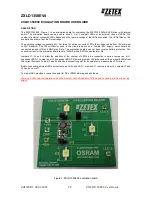
Setup
5
Setup
This section describes the header/jumper connections on the EVM and getting started using the
TPS65982-EVM.
5.1
Header, Jumper, Switch, Push Button and Test Point Descriptions
The headers, jumpers, switches, push buttons, and test points are listed in the order they can be found on
the PCB, from top left to bottom right, across then down. However, related jumpers/headers/test points are
listed simultaneously.
5.1.1
S1: Switch Bank #1
Switch bank S1 contains four DIP switches, three of which are used to control the three bits/pins [B2:B0]
of the configuration options for the TPS65982-EVM, shown in
. Bit [B0] is connected to the GPIO1
pin of the TPS65982 IC (U2) and is pulled low when the upper-most switch is pushed to the left-hand side,
pin 1 of S1. Bit [B0] is pulled high when the upper-most switch is pushed to the right-hand side, pin 8 of
S1. Bit [B1] is connected to the DEBUG3 pin of the TPS65982 IC (U2) and is pulled low when the middle-
upper switch is pushed to the left-hand side, pin 2 of S1. Bit [B1] is pulled high when the middle-upper
switch is pushed to the right-hand side, pin 7 of S1. Bit [B2] is connected to the DEBUG4 pin of the
TPS65982 IC (U2) and is pulled low when the middle-lower switch is pushed to the left-hand side, pin 3 of
S1. Bit [B2] is pulled high when the middle-lower switch is pushed to the right-hand side, pin 6 of S1. Bit
[B3] is connected to the TPS65982 IC (U2), however, is not used for any configuration.
5.1.2
S2 (Not Populated): Switch Bank #2
Switch bank S2 contains four DIP switches which are used to control four bits/pins [B3:B0] of the
TPS65982-EVM. Bit [B0] is connected to the DEBUG_CTL1 pin of the TPS65982 IC (U2) and is pulled
low when the upper-most switch is pushed to the left-hand side, pin 1 of S1. Bit [B0] is pulled high when
the upper-most switch is pushed to the right-hand side, pin 8 of S1. Bit [B1] is connected to the
DEBUG_CTL2 pin of the TPS65982 IC (U2) and is pulled low when the middle-upper switch is pushed to
the left-hand side, pin 2 of S1. Bit [B1] is pulled high when the middle-upper switch is pushed to the right-
hand side, pin 7 of S1. Bit [B2] is connected to the BUSPOWERZ and LDO_3V3 pins of the TPS65982 IC
(U2) while bit [B3] is connected to the BUSPOWERZ and LDO_1V8D pins of the TPS65982 IC (U2).
BUSPOWERZ is pulled low when the middle-lower and lowest switches are pushed to the left-hand side,
pins 3 and 4 of S1. Bit [B2] is pulled high and BUSPOWERZ is pulled up to LDO_3V3 when the middle-
lower switch is pushed to the right-hand side, pin 6 of S1. Bit [B3] is pulled high and BUSPOWERZ is
pulled up to LDO_1V8D when the lowest switch is pushed to the right-hand side, pin 5 of S1. The middle-
lower and lowest switches of S1, bits [B2] and [B3] should never both be pushed to the right-hand side,
pins 6 and 5.
5.1.3
J7 (Not Populated): Tiva LaunchPad Power and System Power Jumpers
Jumper J7 is a set of 2 surface-mount jumpers to connect power from a LaunchPad to the System Power
rails of the TPS65982 IC (U2). Connecting a shunt between pins 1 and 2 will connect System_5V to
Tiva_5V and will allow the 5-V rail of the TPS65982-EVM to be powered by the 5-V rail of the Tiva
LaunchPad. Connecting a shunt between pins 3 and 4 will connect System_3V3 to Tiva_3V3 and will
allow the 3.3-V rail of the TPS65982-EVM to be powered by the 3.3-V rail of the Tiva LaunchPad. Both of
these shunts can be connected simultaneously.
5.1.4
J4: Barrel Jack Receptacle for 20-V AC Adapter
Receptacle J4 is intended to mate with a barrel-jack plug that will provide 20-V DC that has been rectified
by an AC Adapter. The size, polarity, and voltage of the plug must match in order to safely provide power
to the External Power rail TPS65982-EVM. A standard Dell or HP notebook adapter or similar will provide
the needed power. For example, the Dell 130W Part Number: 492-BBGP.
8
TPS65982 Evaluation Module
SLVUAF8C – June 2015 – Revised November 2015
Copyright © 2015, Texas Instruments Incorporated








































